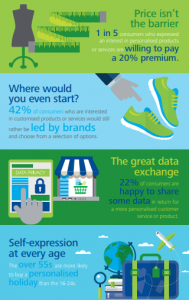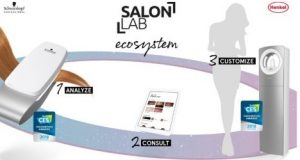Era of change from Mass customization to personalization
Receiving an email with your name at the top instead of a generic subject line or salutation was primarily the start of the first mass customization marketing campaign. This email campaign in its initial days was a success because people felt connected. Hearing or reading their name enticed them, as different parts of their brain light up giving them a sensation of belongingness. It was a time when personalization was synonymous with luxury.
Before moving forward, first we need to define what is mass customization and personalization.
Mass customization: It is the use of flexible computer-aided service and manufacturing system which produces custom outputs while keeping the costs closer to the mass-produced products. According to Operations Management for Competitive Advantage mass customization is the method of “effectively postponing the task of differentiating a product for a specific customer until the latest possible point in the supply network.”
Personalization: It is the year 2054, a man walks into a mall and a camera scans his retina and identifies him. As he moves along, the advertisement changes on the board, targeting him specifically, calling out his name and offering special deals for him. He steps into a Gap store and a hologram wishes him with his name and displays him the clothes that match his taste. This is a scene from a movie Minority Report played by Tom Cruise. This is called as personalization. It is tailor-made products and services which allows customers to choose the specifications of a product or service. The end product is in accordance with the users’ tastes and preferences which is only meant for that individual.
Birth of Mass Customization
During the era of IBM and Compaq, Dell came as disruptor with its customized offerings. When the distribution channel involved clearance agent, distributor, wholesaler and retailer, Dell moved forward with a business model bypassing all the mediators. They allowed the customers to custom build their laptops according to their needs.

Directly shipping the product from the inventory of the company to the house of customer, gave Dell a cost advantage in the industry. They were able to maintain less inventory thus lowering holding cost, aiding them to have low inventory turnover ratio. In the end, mass customization not only helped them to gain satisfy the needs of the customers but also helped them gain competitive advantage.
Era of change
This customization that we witness everywhere is transforming

into personalization and the most benefiting side is marketeers. With all the big data, machine learning and artificial intelligence, the scope of personalization is increasing day by day. According to McKinsey, targeted communication that is relevant and meaningful for the customer can create long-lasting customer loyalty and drive revenue growth from 10 to 30 percent. Millennials are now predominant today and marketeers are having a hard time pleasing them. Accenture Industry Report (Retail) answers the question that who are millennials shoppers and what they want? It boils down to three points:
1. Personalized offerings across all channels with better, faster and more memorable service.
2. A single conversation with the brand, one that stays same across smartphones, desktops and stores.
3. A collaboration of technology, data, analytics and process which provides a personalized service.
Yes, personalization is the key to engage millennials with the brand but when someone receives an unrelated and unsolicited offer related to something they have done online it feels like that someone is watching you. This kind of a reaction is a by-product of personalization. This is because it is currently in the “uncanny valley” moment. It is a term used to describe the unease of the people to accept a robot or computer-generated content which feels like a person but still do not pass for it.
Implementing personalization
To overcome the challenge and achieve a meaningful personalization, systematic testing of ideas with real customers and reiterating the process is crucial. Now tools and capabilities to execute operations- delivering personalized offers to millions of customers across channels exists. Consumers also interact with brands through various channels from web, mobile, social media and in-store. Customers expect a seamless and consistent experience wherever they go. To meet these expectations, companies must unleash the power of the customer data within their channels and take action on smart insights to deliver the most personalized experience for each individual in real time. In doing so, they can enhance the value of their omnichannel shopper while increasing the sale, engagement and retention.
In order to create a feedback loop which seamlessly connects the findings of the insights of data and end deliverable, allow smooth flow of data and decision making in real time, it will require integration of three parameters:
1. Data Discovery: It is the finding and combining of traditional and behavioral data which uncovers the meaningful insights about customers. It is easy said than done since the data’s complexity lies with the wide range of it. The CRM system which is used by most of the companies is based on a rigid system which does not have flexibility or scalability to manage a significant amount of structured and unstructured data. It creates a need to build a system which has high processing and analytical capabilities. Alternate to CRM with customer data platform (CDP) has all the capabilities which are far more flexible and interconnected.
2. Decision Making: It is the brain of the system which with the help of analytics model produce propensity score for each customer. Complex decision-making rules and exceptions will be programmed to cover all the ground of personalization. As compared to mass customization this module will be able to provide a two-way communication channel, collecting and tracking customer reaction.
3. Content Distribution: An efficient system will use all the data collected to trigger personalized landing pages and ads to distribute specific offer and experiences across the channels.
Managing the personalization process
Moving from mass production to mass customization can have substantial cost implications, so there must a net benefit to the business in order to pursue this approach. The challenge is to realize the level of services or products that need to be made unique. Consumer interactions are always costly and time-consuming because of which many businesses do not invest in developing personalization capabilities. However, as the competition will grow, companies will have to change their gears and take consumer into the loop. Not doing so they can suffer from lost sales, missed innovation opportunities and excessive inventory.
Creating an ecosystem of personalization by Henkel
Henkel in salon industry made an innovative product that touches the realm of hyper-personalization. 140 years old Henkel launches their Salon Labs technology to bring salons into the digital age. They have created a system which provides a best in class personalized product that caters to the need of specific customer only. It follows three simple steps:
1. Analyze
2. Consult
3. Customize
Using the state of the diagnostic tool developed by Henkel themselves they analyze the hairs of the customer. The technology allows them to analyze hair at the molecular level with near-infrared and visible light sensors to determine attributes like strength, moisture content and true hair color. The data collected is channeled through SalonLab Consultant app for further analyses. The insight from Schwarzkopf Professional beauty consultant is then sent to the machine for customization of the hair product. An optimum mixture of active ingredients is mixed with the base mixture which caters to the need of the specific customer. Whether the customer has dandruff, dry scalp or split ends, the hair product will take care of those particular problems only. The technology was revealed in CES 2018.
This innovation has vast implications for the marketeers. They have a feasible, low cost, mass production and highly customizable product that they can sell to the customers. A hair care product that is not for everyone but only for your hair. One of the primary function of personalization is to increase engagement of the consumer with the brand. Engagement is the extent of customer’s attention and active involvement with a communication. It is much more than a Facebook like or a retweet on Twitter. Engagement can extend personal experiences that augment or transforms firm’s product and services. With personalization, companies give the customer a medium to engage with the brand as seen in Henkel.
Personalization in digital marketing
Another way of looking at the personalization is not through the products or services but the journey that customer takes. For many businesses, mass personalization is the act of developing campaigns targeted towards specific customer with the motive to boost the sales. It is a race to make Minority Report a reality. Amazon is a perfect example of personalizing the journey of customers. They tailor offers that are based on customer’s past purchases, interests, demographic profile and location. Amazon uses this method frequently, and with this technique, they can earn 35 percent of their total revenue from products they recommend. If someone has kids, they will see some children’s book as well as stuff on sales. Apart from Amazon, Netflix also uses mass personalization. They recommend movies to their users based on what they have seen in past, what are their essential interests and their demographics.
Henry Ford’s assembly line technique gave birth to the mass production, exceptionally lowering down the cost of cars. Then came Dell, giving customers the option to customize their products. Now, again the time has come to change the gears. Likes of Henkel and Amazon are moving forward with the mass personalization and soon it will have bandwagon effect which will fuel this paradigm shift. The story does not end here. When people are busy digesting the concept of personalization, some are working on the idea of bespoke, involving customers from the beginning of the process to the end.
References:
https://www.ncbi.nlm.nih.gov/pmc/articles/PMC1647299/
Deloitte: The Deloitte Consumer Review “Made-to-order: The rise of mass personalization”
James D. Roumeliotis, “Mass Customization & Personalization: The Pinnacle of Differentiation and Brand Loyalty”
Juha Tiihonen, Alexander Felfernig, “An introduction to personalization and mass customization”
Kelsey Jones, “Make your customers feel loved with mass personalization”
McKinsey & Company: Brian Gregg, Hussein Kalaoui, Joel Maynes, Gustavo Schuler “Marketing’s Holy Grail: Digital personalization at scale”
McKinsey & Company: Julien Boudet, Brian Gregg, Jane Wong, Gustavo Schuler “What shoppers really want from personalized marketing”

